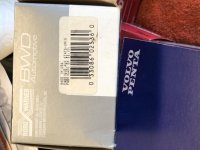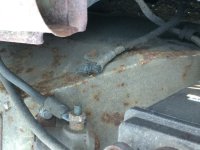Not the best place.
A "best practice" is to run the main battery ground cable to as close to the starter motor as possible. Even if that means all the way to a starter bolt.
In lieu of that however, any available bolt (but not a head bolt!) is legit and Ford put them on the block just below the head and behind the alternator. I've found a threaded hole on the side of many 302's just about mid-way back to the starter that is the perfect spot for some I've done.
Yeah, looks like kind of a mess.
In the original Bronco world, there was just the one negative battery cable (probably 6 gauge) from the battery to the engine block, but with a stop at the wheel well just there around the corner from your starter relay (aka solenoid). If you reach around you will probably feel a small screw hole where it was originally grounded.
When the battery cables are replaced, probably 80% of the people never get around to putting on a body ground.
There was no frame ground on our Broncos, and for some unknown reason Ford did not even think it was necessary to put the usual ground strap between the back of the intake and the firewall. Like they did for most every other vehicle starting sometime in the late sixties I think.
I guess they figured that having the fenders welded to the tube, that was good enough. And it was when they were brand new! But add 50 years of paint, rust, and general separation anxiety, and one of the best things you can do to your Bronco is to add grounds to some of those places.
My recommendation these days if you're using store-bought battery cables is to get 2ga (because it's overkill, and overkill is a good thing with battery cables) and make sure the negative side has the extra 10ga "pigtail" sticking out that you can crimp some extra wire to and run down to the fender or wheel well.
Then add a ground jumper between the engine and firewall and the engine and frame.
You can use plain old 10ga wire, or you can get some of those pre-made braided straps with ring terminals already on each end. They work great and are usually found on the HELP! rack at any parts store.
Then "while you're at it" again, add some additional grounds inside the cabin.
One from the firewall to the metal dash, and if needed from the dash to the instrument cluster.
Yes, the cluster "should" get a very good ground from the four screws that attach it to the dash, but here again that ain't always so.
Just FYI with Bronco grounds, several of us have even run into Broncos that had to have extra jumper wires attached between the radiator core support (where your headlights and turn signals get their ground path) and the inner fenders where the battery ground is. The old spot welds are just not enough to get good flow sometimes.
The other oddball area is the windshield frame. Yes, it's theoretically got a fantastic connection to body sheet metal, but rust seems to reduce that effectiveness.
I have not run into it often, but if you ever have wonky wipers, sometimes it's just the frame in need of a good new ground.
Fun, huh?%)
Paul



















